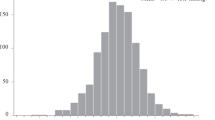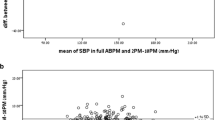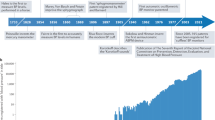Abstract
The objective of this study was to use a nationwide epidemiological survey to investigate the factors that affect within-visit blood pressure (BP) variability. We analyzed the Korean National Health and Nutrition Examination Survey (KNHNES) data for 2005 (n=5488). We examined three within-visit BP variability parameters that include the following: the alarm reaction (AR), defined as the first BP reading minus the third BP reading; the BP discrepancy, defined as the maximal BP reading minus the minimal BP reading (ΔBPmax); and the s.d. (BPSD). Age, fasting glucose, eGFR, total cholesterol, LDL cholesterol, and the metabolic syndrome (MetS) score were the relevant factors that affected the systolic AR, ΔSBPmax and SBPSD. Multiple linear regression models revealed that age (P<0.0001), the office systolic BP (SBP) level (P<0.0001), the MetS score (P<0.0001), the female gender (P=0.007) and the eGFR (P=0.049) were independently associated with the systolic AR, whereas age (P<0.0001), the office SBP level (P<0.0001), and the female gender (P=0.024 and 0.022) were independently associated with ΔSBPmax and SBPSD, respectively. Within-visit BP variability, especially the variability associated with the SBP, was significantly associated with increased age, female gender and cardiovascular risk factors, such as hypertension, low eGFR and adverse glucose and lipid profiles. In addition, increased age, female gender, the eGFR and the MetS score were independently relevant factors that affected the systolic AR. Systolic within-visit BP variability and systolic AR are associated with cardiovascular risk factors.
This is a preview of subscription content, access via your institution
Access options
Subscribe to this journal
Receive 12 digital issues and online access to articles
$119.00 per year
only $9.92 per issue
Buy this article
- Purchase on Springer Link
- Instant access to full article PDF
Prices may be subject to local taxes which are calculated during checkout




Similar content being viewed by others
References
Chobanian AV, Bakris GL, Black HR, Cushman WC, Green LA, Izzo JL et al. Seventh report of the Joint National Committee on Prevention, Detection, Evaluation, and Treatment of High Blood Pressure. Hypertension 2003; 42 (6): 1206–1252.
Mancia G, De Backer G, Dominiczak A, Cifkova R, Fagard R, Germano G et al. 2007 Guidelines for the Management of Arterial Hypertension: The Task Force for the Management of Arterial Hypertension of the European Society of Hypertension (ESH) and of the European Society of Cardiology (ESC). J Hypertens 2007; 25 (6): 1105–1187.
Pickering TG, Hall JE, Appel LJ, Falkner BE, Graves J, Hill MN et al. Recommendations for blood pressure measurement in humans and experimental animals: Part 1: blood pressure measurement in humans: a statement for professionals from the Subcommittee of Professional and Public Education of the American Heart Association Council on High Blood Pressure Research. Hypertension 2005; 45 (1): 142–161.
Rothwell PM . Limitations of the usual blood-pressure hypothesis and importance of variability, instability, and episodic hypertension. Lancet 2010; 375 (9718): 938–948.
Rothwell PM, Howard SC, Dolan E, O'Brien E, Dobson JE, Dahlof B et al. Effects of beta blockers and calcium-channel blockers on within-individual variability in blood pressure and risk of stroke. Lancet Neurol 2010; 9 (5): 469–480.
Rothwell PM, Howard SC, Dolan E, O’Brien E, Dobson JE, Dahlof B et al. Prognostic significance of visit-to-visit variability, maximum systolic blood pressure, and episodic hypertension. Lancet 2010; 375 (9718): 895–905.
Webb AJ, Fischer U, Mehta Z, Rothwell PM . Effects of antihypertensive-drug class on interindividual variation in blood pressure and risk of stroke: a systematic review and meta-analysis. Lancet 2010; 375 (9718): 906–915.
Parati G . Blood pressure variability: its measurement and significance in hypertension. J Hypertens Suppl 2005; 23 (1): S19–S25.
Kikuya M, Hozawa A, Ohokubo T, Tsuji I, Michimata M, Matsubara M et al. Prognostic significance of blood pressure and heart rate variabilities: the Ohasama study. Hypertension 2000; 36 (5): 901–906.
Mancia G, Bombelli M, Facchetti R, Madotto F, Corrao G, Trevano FQ et al. Long-term prognostic value of blood pressure variability in the general population: results of the Pressioni Arteriose Monitorate e Loro Associazioni Study. Hypertension 2007; 49 (6): 1265–1270.
Sega R, Corrao G, Bombelli M, Beltrame L, Facchetti R, Grassi G et al. Blood pressure variability and organ damage in a general population: results from the PAMELA study (Pressioni Arteriose Monitorate E Loro Associazioni). Hypertension 2002; 39 (2 Pt 2): 710–714.
Kim HM, Kim DJ, Jung IH, Park C, Park J . Prevalence of the metabolic syndrome among Korean adults using the new International Diabetes Federation definition and the new abdominal obesity criteria for the Korean people. Diabetes Res Clin Pract 2007; 77 (1): 99–106.
Lawlor DA, Smith GD, Ebrahim S . Does the new International Diabetes Federation definition of the metabolic syndrome predict CHD any more strongly than older definitions? Findings from the British Women’s Heart and Health Study. Diabetologia 2006; 49 (1): 41–48.
Bovet P, Gervasoni JP, Ross AG, Mkamba M, Mtasiwa DM, Lengeler C et al. Assessing the prevalence of hypertension in populations: are we doing it right? J Hypertens 2003; 21 (3): 509–517.
Manios ED, Koroboki EA, Tsivgoulis GK, Spengos KM, Spiliopoulou IK, Brodie FG et al. Factors influencing white-coat effect. Am J Hypertens 2008; 21 (2): 153–158.
Pickering TG, Gerin W, Schwartz AR . What is the white-coat effect and how should it be measured? Blood Press Monit 2002; 7 (6): 293–300.
Su H, Wang J, Zhu Y, Wang G, Cheng X . Discrepancy among three blood pressure readings within one measurement and relevant influencing factors. Blood Press Monit 2010; 15 (3): 152–157.
Mancia G, Parati G, Pomidossi G, Casadei R, Di Rienzo M, Zanchetti A . Arterial baroreflexes and blood pressure and heart rate variabilities in humans. Hypertension 1986; 8 (2): 147–153.
Spruill TM, Pickering TG, Schwartz JE, Mostofsky E, Ogedegbe G, Clemow L et al. The impact of perceived hypertension status on anxiety and the white coat effect. Ann Behav Med 2007; 34 (1): 1–9.
Myers MG, Reeves RA . White coat effect in treated hypertensive patients: sex differences. J Hum Hypertens 1995; 9 (9): 729–733.
Gosse P, Promax H, Durandet P, Clementy J . ‘White coat’ hypertension. No harm for the heart. Hypertension 1993; 22 (5): 766–770.
Muntner P, Levitan EB, Reynolds K, Mann DM, Tonelli M, Oparil S et al. Within-visit variability of blood pressure and all-cause and cardiovascular mortality among US adults. J Clin Hypertens 2012; 14 (3): 165–171.
Michell AR . Prognostic significance of blood-pressure variability. Lancet 2010; 376 (9739): ): 413; author reply 414–415.
Klungel OH, de Boer A, Paes AH, Nagelkerke NJ, Seidell JC, Bakker A . Estimating the prevalence of hypertension corrected for the effect of within-person variability in blood pressure. J Clin Epidemiol 2000; 53 (11): 1158–1163.
Keenan K, Hayen A, Neal BC, Irwig L . Long term monitoring in patients receiving treatment to lower blood pressure: analysis of data from placebo controlled randomised controlled trial. BMJ 2009; 338: b1492.
Ohkubo T, Asayama K, Imai Y . The value of self-measured home blood pressure in predicting stroke. Expert Rev Neurother 2006; 6 (2): 163–173.
Acknowledgements
We thank the Korea Centers for Disease Control and Prevention, which performed the KNHANES, and all the participants in the present study for their generous cooperation.
Author information
Authors and Affiliations
Corresponding author
Ethics declarations
Competing interests
The authors declare no conflict of interest.
Rights and permissions
About this article
Cite this article
Shin, J., Shin, J., Kim, B. et al. Within-visit blood pressure variability: relevant factors in the general population. J Hum Hypertens 27, 328–334 (2013). https://doi.org/10.1038/jhh.2012.39
Received:
Revised:
Accepted:
Published:
Issue Date:
DOI: https://doi.org/10.1038/jhh.2012.39
Keywords
This article is cited by
-
Factors associated with intra-individual visit-to-visit variability of blood pressure in four countries: the INTERMAP study
Journal of Human Hypertension (2019)
-
Relationship between Within-Visit Blood Pressure Variability and Skeletal Muscle Mass
The journal of nutrition, health & aging (2019)
-
Association between within-visit systolic blood pressure variability and development of pre-diabetes and diabetes among overweight/obese individuals
Journal of Human Hypertension (2018)
-
Within-visit blood pressure variability is associated with prediabetes and diabetes
Scientific Reports (2015)
-
Factors affecting variability in home blood pressure in patients with type 2 diabetes: post hoc analysis of a cross-sectional multicenter study
Journal of Human Hypertension (2014)



